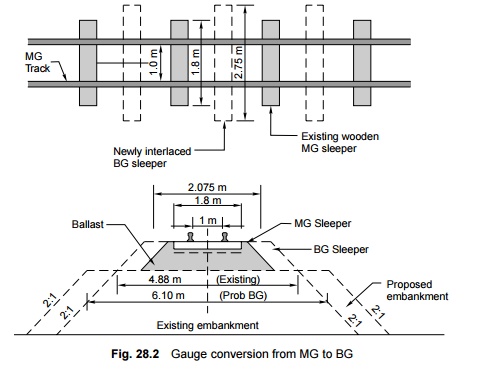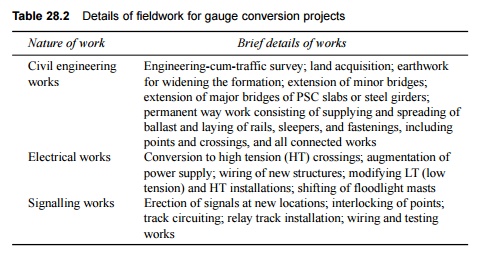Chapter: Civil : Railway Airport Harbour Engineering : Railway Engineering : Construction of New Railway Lines and Track Linking
Gauge Conversion
Gauge Conversion
A number of projects have
recently been taken up by Indian Railways for converting railway lines from
meter gauge to broad gauge. Gauge conversion projects (Fig. 28.2)
basically aim at providing a uniform gauge for the smooth and fast flow of
traffic, which may be necessitated either due to strategic reasons or on
account of operating considerations.
The main advantages of gauge
conversion as well as its details are discussed in Chapter 2.
1 Execution of Gauge Conversion Projects
Details of works The
fieldwork normally involved in gauge conversion projects is presented in
Table 28.2.


Planning of works Gauge
conversion projects require detailed planning as they involve expansion,
which needs to be carried out in a tight time schedule and multifarious
activities such as assigning of contracts; posting and management of manpower,
including supervisors and artisans, etc.; supply of track materials; and
coordination between the engineering, service and telegraph, electrical,
operating, and various other departments. Most of the engineering work is done
by placing traffic blocks on a regular basis while the residual work is finally
completed after placing an extended traffic block of several consecutive days
on the route, during which time gauge conversion works are executed on a war
footing.
Manpower requirement The
manpower required for the various tasks involved in a gauge conversion
project is to the tune of about 80 labourers per km to ensure that gauge
conversion is completed within 30 days in all respects. One PWI and one AEN
should be assigned for one- and two-block sections, respectively, for the
continuous monitoring of the progressing work to ensure the requisite quality
control. The contractor should also engage at least two competent supervisors
per block section in addition to the trained permanent way mates appointed for
each gang.
Speed potential Two
rounds of packing by light off-track tampers such as phooltas or chinese
tampers are required to make the track fit for a speed of 50 km/h. This is
further supplemented by two more rounds of packing using heavy on-track tie
tamping machines for making the track fit for a speed of 100 km/h.
Economy measures Gauge
conversion projects are capital intensive and adequate financial
resources have to be mobilized to meet these ambitious targets. The Railway Ministry
has, therefore, taken a decision that all schemes of gauge conversion are to be
carried out in the most economical way. By cutting down the cost of gauge
conversion in various ways, the Railways plan to carry out gauge conversion
works at an economical cost of Rs 6 to 7 million per km as against the normal
cost of Rs 9 to 10 million per km, thereby saving about 30 to 40% on the
initial cost. The guidelines to be followed in this regard are the following.
(a) The
maximum permissible speed on the converted BG section need not be more than
what was previously specified for the MG section.
(b) The
facilities required at the stations should not be more than what has already
been provided except that the loop length should be 686 m.
(c) The
length of the platform at those stations that currently serve as stops for
mail/express trains should be just enough for accommodating l6 coaches. If the
existing platform needs to be extended, the extended portion should be
constructed at rail level. On suburban sections, the length of the platform
should be enough for 12 coaches. At important stations, the platform length
should be sufficient for no more than 22 coaches with added provisions for
future expansion to include 26 coaches.
2 Civil Engineering Works of Gauge Conversion
Projects
Engineering-cum-traffic surveys The
survey is done to examine the technical feasibility of the proposal and
the economical aspects of the same.
Land acquisition The land
requirement for converting the track from MG to BG is assessed and, if
necessary, extra land is acquired as per the existing procedure laid down in
the Land Acquisition Act.
Earthwork Earthwork is done on either side
of the existing formation of a single-line track to increase its width from
4.88 m (16 ft) to 6.10 m (20 ft) in the case of embankments and from 4.27 m (14
ft) to 5.49 m in the case of cuttings.
Bridges and culverts The
existing bridges and culverts are extended to suit the BG formation and
to conform to the standards adopted for BG sections. The extension of these
bridges is properly planned to ensure the minimum dislocation of traffic.
Track linking
Track linking involves the following operations.
Unloading of track material Track
material such as rails, sleepers, and fastenings are taken from
the base depot to the work site and unloaded at the final location. Preliminary
works such as boring and adzing of sleepers, proper matching of rails, and
drilling of holes in the rails are planned in advance.
Interlacing of sleepers Wooden
sleepers are best suited for gauge conversion projects, if
available. They are interlaced with the existing sleepers of the track and the
two are spiked together.
Arrangements of men and materials The
deployment of manpower, including the supervising staff, is
planned in detail so that the conversion of the track from MG to BG is achieved
with minimum interruption of traffic. Normally 50 to 100 men per km work are
required on the track during a traffic block. In addition, the work of skilled
artisans such as blacksmiths is also required for track conversion. All track
material, including fittings, are properly organized and arranged at the site.
Tools and equipment such as augers and drills, Jim Crows, crowbars, rail tongs,
sleeper tongs, and spanners are also arranged in adequate quantities.
Traffic blocks Traffic
is suspended on the railway line for a period of 15 to 30 days depending
upon the length of the track to be dealt with, so that the work of gauge
conversion can be carried out at one stretch. During a traffic block, traffic
is diverted on alternate routes or trans-shipped onto road vehicles.
Linking the new track During
the traffic block, the existing rails are removed and new rails
placed in what is to be their final position on the BG track. The new sleepers
are also placed in their proper position and the rails are spiked to the
sleepers as per BG requirements. The track is properly levelled and aligned and
traffic is allowed on the new line at a restricted speed after obtaining the
sanction of the commissioner of railway safety.
Ballasting and packing An
adequate quantity of ballast is then put in the track and the
track is properly packed. The speed restrictions are gradually relaxed as the
stability of the track improves.
Related Topics